Why spring’s perfect for trekking Andalusia’s new long-distance footpath
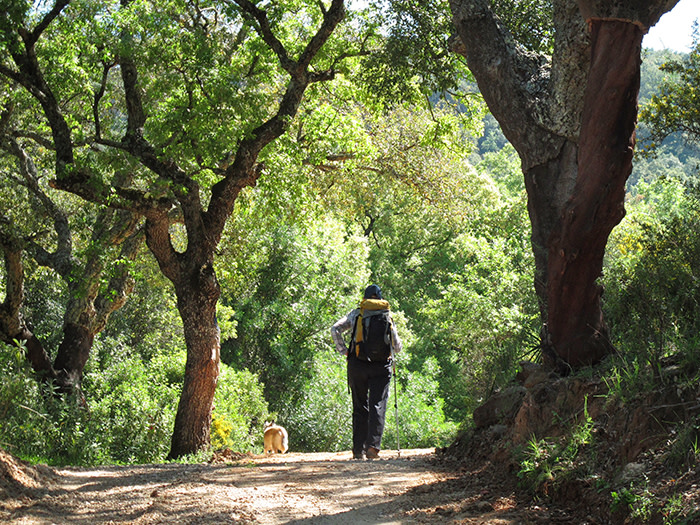
Simply sign up to the Life & Arts myFT Digest -- delivered directly to your inbox.
I nurse a deep suspicion of set-piece walks. I have never trudged the Pennine Way, nor the Annapurna Circuit. As for Everest, having once been lucky enough to climb a new route up the Kangshung Face all the way to the summit, I could never be bothered to join the queues on the now hackneyed trek to the Nepalese base camp. Perhaps, like many climbers, I was just lazy about walking long distances. Or an elitist misanthrope, too proud to follow the herd? But all that changed last Easter when I set off on the new GR 141 route, a six-stage waymarked trail through the mountains of Andalusia.
This epiphany was prompted by my wife Rosie, who has a horror of the unscheduled. She likes to follow a set planned route and ever since the occasion in Asturias when my erratic map-reading had her crawling on hands and knees through untracked thickets of gorse, she has been determined to avoid unnecessary jungle-bashing. She has a point, because the Mediterranean scrub that cloaks much of the Serranía de Ronda, where we now live for part of the year, is prickly, at times impenetrable. Ambiguous maps, haphazard trails and the barbed wire fences that criss-cross the largely private land add further spice. In the face of those challenges, a clear signposted trail, with guaranteed right of way through some of Europe’s most stunning scenery, seemed very attractive. This would be a gentle trek through meadows and forests, with rocky summits as backdrop, not compulsory goals. And I liked the fact that the GR 141 was a grand circuit, starting and finishing in the elegant and historic town of Ronda.
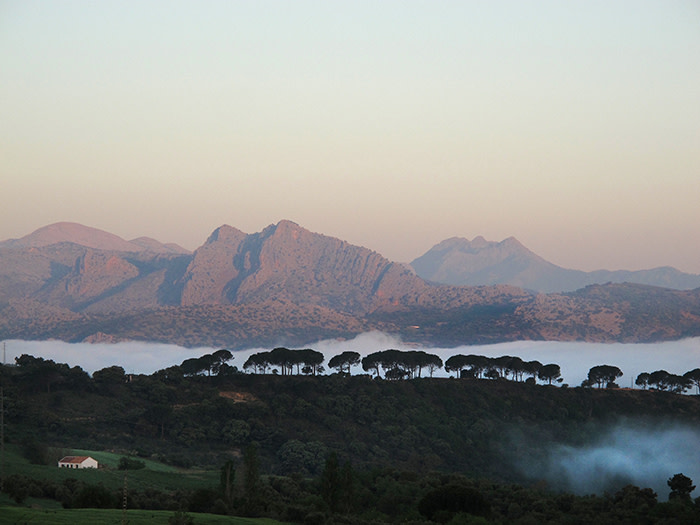
The three of us — Rosie, our dog Willow and I — set off on a balmy spring afternoon, walking beneath the huge ochre cliffs spanned by Ronda’s monumental Puente Nuevo. After a couple of hours we stopped to rest and eat beside a river where goldfinches and whitethroats flitted among the poplar trees. In deeper thickets the invisible nightingales trilled their virtuoso mating arias.
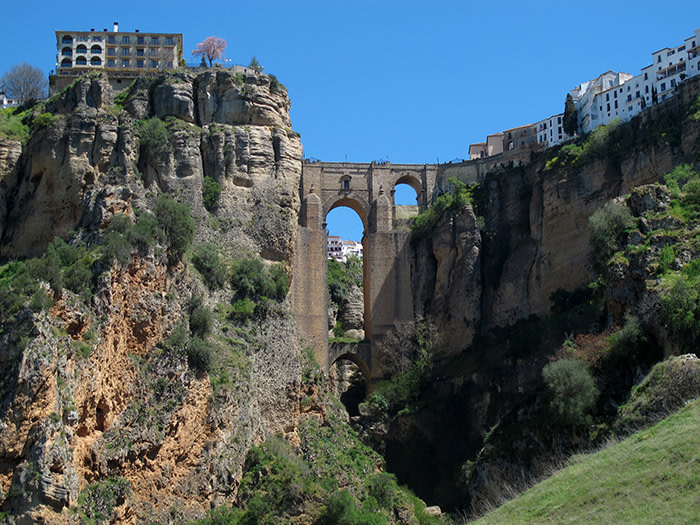
After lunch, on this, our very first day, I broke my vow of conformity and suggested a “more interesting” variation. Instead of the prescribed route to Benaoján, we would briefly follow the higher GR 7 to the village of Montejaque, where I had booked a room for the night. Luckily the hot climb was easy to follow and was rewarded with a magical finish — an Arcadian idyll with flocks of young goats frolicking in emerald meadows among gleaming towers of limestone, before a zigzag cobbled track took us down into Montejaque, one of the most picturesque of all the pueblos blancos, nestled among russet cliffs.
The GR 141, which was launched in 2015, is the creation of Malaga’s provincial government. With EU funding, it restored existing paths and linked them together, adding new signposts and gates, as well as publishing a detailed, downloadable guide to the route. It doesn’t include accommodation listings but the small hotels, bed and breakfasts and private apartments in the villages along the route are easy enough to find online. Officially there are six stages but we took a gentler approach, stopping at intervening villages and taking nine days to complete the circuit.
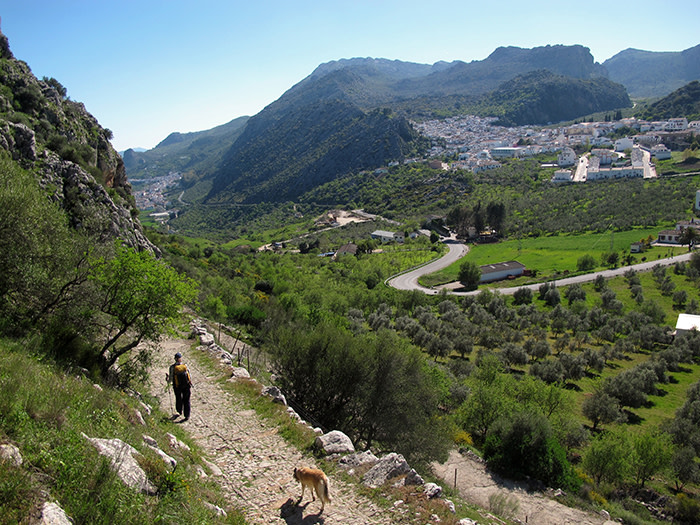
We ate that first night in a bar called La Questa. It was loud and welcoming and the young woman who served our tapas said there was no problem with our dog coming in out of the cold. It was Saturday, with football on TV, and every time Málaga scored against Barcelona the owner cheered tipsily.
One of the things I love about a multi-day walk is the sense of continuity, setting off each morning on foot, heading for a new destination, freed from the scourge of motorised transport. I like to start early in the morning. In Spain that means setting off without breakfast, but that was fine this Sunday morning, as we only had to stroll for an hour down to Benaoján to rejoin the GR 141 just as the café next to the railway station was opening. For €2 we each had a cortado (strong coffee with a little milk) and our favourite walker’s breakfast, tostada — a large piece of toast, rubbed with raw garlic and olive oil, then spread with puréed tomato and topped with slices of Benaoján’s famed jamón. If we had had the time, we might have hung around to enjoy the excellent restaurant at the nearby Molino del Santo.
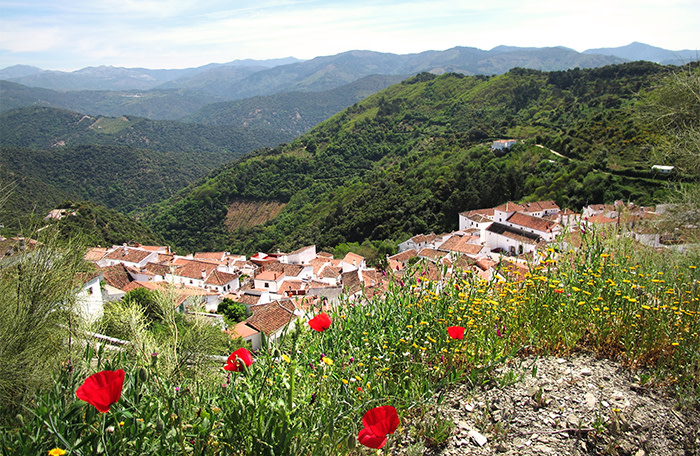
Instead we carried on walking. This section — still officially part of the first stage — is pure sylvan delight, especially in spring, when the deciduous oaks are bursting into translucent leaf, the evergreen holm oaks are festooned with pale yellow flowers and, if you are lucky, you might see a shy golden oriole flitting among the boughs. The path contours along the left bank of the Rio Guadiaro and is known as “Mr Henderson’s Walk” after Sir Alexander Henderson, who financed the railway built along the other side of the river in the 1890s, linking Algeciras to Ronda. The train still runs several times a day, calling at the riverside stations built to serve the villages that sit higher up on the hillside.
On this second, short day, we stopped for lunch at Barriada de la Estación before climbing to the village of Jimera de Líbar. Day three was another short walk, through a landscape of cork oak forest and walnut groves, to Estación Cortes. On day five we saw the first wild peonies of the year, the open hillside covered in blowsy crimson-pink blooms. An hour further on we descended a steep zigzag to the “German Bridge” that spans a spectacular gorge where the Rio Guadiaro churns 100 metres below, in a dark cleft barely 10 metres wide. This is classic karst country, the limestone dissolved and sculpted into fantastic fluted, scalloped pinnacles and gargoyles.
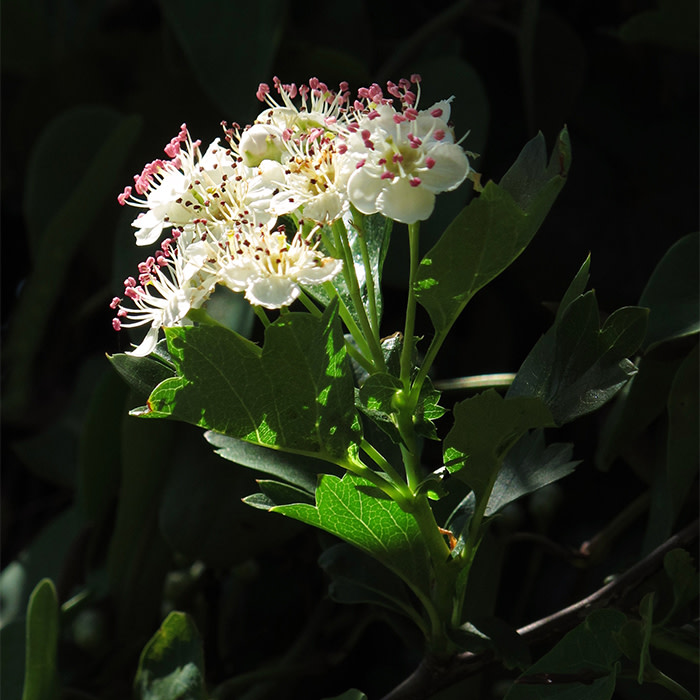
Onward to El Colmenar, also called Estación de Gaucín, which can confuse the unwary, because it is actually a steep four hour walk from the station to Gaucín itself. However, on a spring morning, climbing first through dewy meadows then dappled forest I almost felt that we could be walking through the pages of a Hardy novel.
Unlike Hardy’s Dorset though, this corner of Andalusia has still not suffered the ravages of intensive farming. The wildflowers flourish and the vultures circle majestically on the warm thermals. The gleaming limestone summits have an austere wildness, but they rise above the Alcornocales — the biggest cork oak forest in the Mediterranean, where in the autumn the black pigs forage contentedly. In summer the lands may be seared tawny but from autumn to spring this is a green landscape, punctuated by the white villages which cling to the hillsides. That jostling of the elemental and the domestic is one of the things that originally brought us to the Serranía de Ronda and that morning, rounding a corner of the mountainside, it was good to look down onto what has become our home — a tightly-knotted thread of houses strung along the crest of a ridge, dominated by a suitably picturesque Moorish castle perched on a karst outcrop.
Gaucín has a good selection of tapas bars. For something more sophisticated the best restaurant is Platero & Co, run by Barry and Helen from Holland. However, for us it felt good to eat on our own terrace that evening, enjoying the familiar view past Gibraltar to Morocco, and having a late lie-in before doing another half stage the next day.
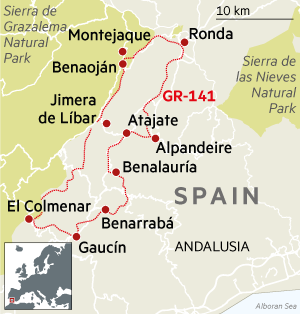
From Gaucín the route heads back north-east, criss-crossing — and occasionally following for a very short distance — the A367 road to Ronda. Our first half stage took us along the Guadiaro side of the ridge, then over on to the Genal side, descending through acres of gleaming white and pink sunroses. We were in cistus heaven, followed later that afternoon by citrus heaven as the heady scent of orange blossom wafted us up to the village of Benarrabá. We had hoped to stay at the much-praised Banu Rabbah hotel, but this being Holy Week it was fully booked, so we took a taxi back home and returned in the morning to continue the route, which now descends to an enchanted track along the woody bank of the Rio Genal, with some impressive new metal walkways along a couple of precipitous sections, installed as part of the GR 141 upgrading. On Good Friday, this delightful section of the trail was busy with holidaymakers. Equally crowded, with a lovely holiday atmosphere, was the excellent riverside San Juan restaurant, placed perfectly for a lazy lunch before the steep climb back up the side of the valley to Benalauría.
Another short day took us to Atajate. Then on day nine, Easter Sunday, we got up early, leaving before dawn for what was going to be a long 26-kilometre day, covering a stage and a half of the official route. Long but hugely rewarding. For us semi-locals it was wonderful to discover a new gorge, nestled deep in the bleak limestone uplands. It was also good, approaching the high point of 1,000 metres, to hear the unforgettable cry of mountain choughs. As on all the previous days, a combination of map, notes downloaded from the internet and the red and white waymarks kept us on route — until we reached the large private estate of Coto Alto, where a man in a pick-up truck told us to turn back.
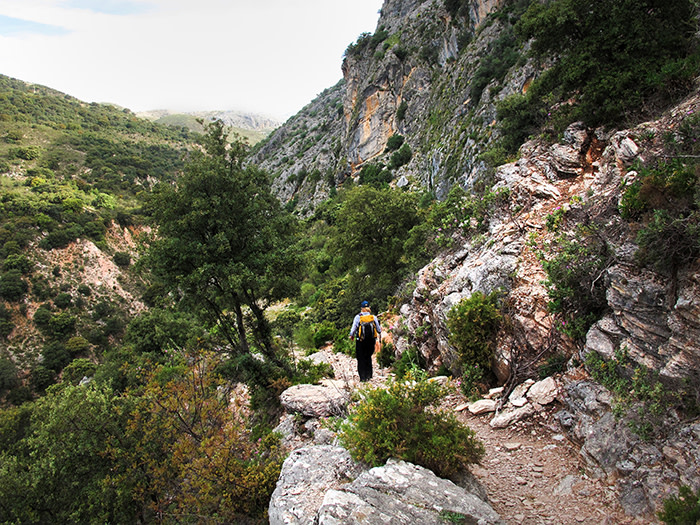
We waited for him to roar off in an aggressive cloud of dust, then carried on, albeit discreetly, missing the walkers’ gate and at one stage having to climb a high fence, posting Willow through a dog-sized slot in the steel bars. It was hugely satisfying to defy Pick-up Man, navigating through the estate until the waymarks re-appeared at the entrance to an enchanting sandstone gorge famous for its characteristic fan-shaped rock. From there an exquisitely cobbled track led up to a tarmac road, and the final hot trudge into Ronda’s southern district of San Francisco, where we guzzled celebratory beers in the holiday Easter crowds.
Stephen Venables was the first Briton to climb Everest without supplementary oxygen and made a series of Himalayan first ascents between the late 1970s and 1990s
Details
There is a detailed description, with English translation, of the six sections of the GR 141 at gransendademalaga.es; a pdf guide can be downloaded from malaga.es. Stephen Venables walked the route in early April, when the hottest day was only 26ºC, but the spring flowers are even more spectacular in May; by June it can be uncomfortably hot
Follow @FTLifeArts on Twitter to find out about our latest stories first. Subscribe to FT Life on YouTube for the latest FT Weekend videos
Comments